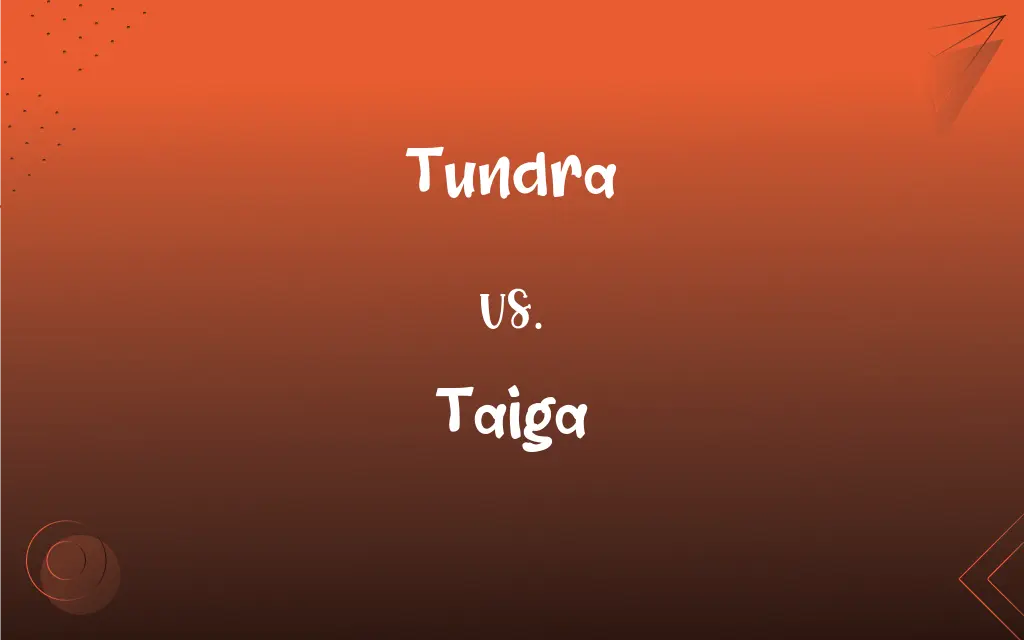Tundra vs. Taiga: What's the Difference?
Edited by Aimie Carlson || By Janet White || Published on November 7, 2023
Tundra is a treeless, cold region with low vegetation, while Taiga, also called boreal forest, is characterized by coniferous trees and is slightly warmer.

Key Differences
Tundra and Taiga are both biomes found in colder climates, but they are distinct in their vegetation and overall characteristics. Tundra regions are primarily located in the Arctic and high-altitude areas. They're characterized by their frozen subsoil and absence of trees. The climate is harsh, with low temperatures and short growing seasons. Taiga, on the other hand, is the world's largest biome, mostly found in Canada, Scandinavia, and Russia, and is dominated by coniferous trees such as spruce, pine, and fir.
Tundra has a landscape that appears barren at first glance. Due to permafrost, a layer of frozen soil, it's hard for deep-rooted plants to survive. Instead, the Tundra is home to mosses, lichens, and some shrubs. Taiga, with its vast stretches of coniferous forests, offers a more dense vegetation cover. The trees in the Taiga have needle-like leaves that prevent water loss and are well-suited for the cold.
Wildlife in the Tundra includes animals adapted to extreme conditions, like caribou, arctic foxes, and snowy owls. These creatures have adapted to make the most out of the brief summers and to survive the challenging winters. In contrast, the Taiga supports a broader range of animals, including bears, wolves, and lynxes, all of which thrive in the forested environment.
In terms of human settlement, the Tundra is relatively uninhabited due to its severe conditions, whereas the Taiga has seen more human habitation, especially in regions where logging is an essential industry. Both biomes are crucial indicators of climate change, with the Tundra experiencing rapid warming and the Taiga seeing shifts in tree distribution and animal populations.
Comparison Chart
Primary Vegetation
Mosses, lichens, and shrubs
Coniferous trees like spruce, pine, and fir
ADVERTISEMENT
Climate
Extremely cold with short summers
Cold winters and warmer summers
Soil
Permafrost, preventing deep-rooted plants
Well-drained, acidic soil
Wildlife
Caribou, arctic foxes, snowy owls
Bears, wolves, lynxes
Human Habitation
Sparse due to harsh conditions
More common, especially in logging areas
Tundra and Taiga Definitions
Tundra
A cold biome with treeless plains and permafrost.
The Arctic Tundra is home to unique flora and fauna.
ADVERTISEMENT
Taiga
A biome dominated by coniferous forests.
The Taiga stretches across much of Canada and Russia.
Tundra
An area where cold temperatures hinder tree growth.
The Tundra's harsh conditions challenge even the hardiest plants.
Taiga
A habitat known for its dense coniferous vegetation.
Wildlife thrives in the dense woods of the Taiga.
Tundra
A zone preceding polar ice caps and following Taiga.
As you move northward from the Taiga, you'll encounter the Tundra.
Taiga
A region with cold winters and needle-leaved trees.
Spruce and fir trees are common in the Taiga.
Tundra
A habitat marked by its frozen subsoil.
The presence of permafrost makes the Tundra unique among biomes.
Taiga
The largest terrestrial biome, often called boreal forest.
The Taiga covers vast areas but remains relatively unexplored.
Tundra
A region with short growing seasons and low vegetation.
Migratory birds flock to the Tundra during brief summers.
Taiga
A transitional zone between temperate forests and Tundra.
As one moves north, the Taiga gradually gives way to the Tundra.
Tundra
A treeless area beyond the timberline in high-latitude regions, having a permanently frozen subsoil and supporting low-growing vegetation such as lichens, mosses, and shrubs.
Taiga
A subarctic area of northern Eurasia and North America located just south of the tundra and covered largely with coniferous forests dominated by firs and spruces.
Tundra
A similar area found at high elevations.
Taiga
A subarctic zone of evergreen coniferous forests situated south of the tundras and north of the steppes in the Northern Hemisphere.
Tundra
A flat and treeless Arctic biome.
Tundra
One of the level or undulating treeless plains characteristic of northern arctic regions in both hemispheres; the term is most commony associated with the arctic plains of Siberia. The tundras mark the limit of arborescent vegetation; they consist of black mucky soil with a permanently frozen subsoil, but support a dense growth of mosses and lichens, and dwarf herbs and shrubs, often showy-flowered.
Tundra
A vast treeless plain in the arctic regions between the ice cap and the tree line
FAQs
Which is colder, Tundra or Taiga?
Tundra is colder than Taiga.
Do trees grow in the Tundra?
No, the Tundra is characterized by a lack of trees due to permafrost.
Is the Taiga found only in the Northern Hemisphere?
Yes, the Taiga, or boreal forest, is exclusive to the Northern Hemisphere.
Why is the Tundra's growing season so short?
Due to extremely cold temperatures and permafrost, the Tundra has a brief summer.
How does climate change impact the Tundra?
The Tundra is experiencing rapid warming, affecting wildlife and melting permafrost.
Are there human settlements in the Tundra?
Human settlements in the Tundra are sparse due to its severe conditions.
What kind of trees are common in the Taiga?
Coniferous trees, such as spruce, pine, and fir, dominate the Taiga.
How do animals in the Taiga adapt to cold winters?
Many Taiga animals have thick fur or hibernate during cold months.
Why are Taiga forests primarily coniferous?
Coniferous trees are adapted to the cold and acidic soil of the Taiga.
Is there any overlap between Tundra and Taiga regions?
There are transitional areas where characteristics of both biomes are present.
What's the significance of the Taiga's needle-like leaves?
They prevent water loss and are well-suited for the cold.
Are human activities threatening the Taiga?
Logging and other industries pose threats to the Taiga's ecosystem.
How do plants in the Tundra survive harsh conditions?
Tundra plants are often short, grow close to the ground, and have shallow roots.
How does the fauna of the Tundra differ from the Taiga?
While both have cold-adapted animals, Tundra fauna is adapted to treeless plains, while Taiga fauna thrives in forests.
Can one find polar bears in the Tundra?
Yes, polar bears are found mainly in the Arctic Tundra.
How does global warming impact the Taiga?
Warming can shift tree distribution and animal populations in the Taiga.
Which biome is larger in area, Tundra or Taiga?
The Taiga is the world's largest terrestrial biome.
Is permafrost found in the Taiga?
While predominantly a Tundra feature, some Taiga regions might have permafrost.
Is fire a natural part of the Taiga ecosystem?
Yes, fires help regenerate the Taiga by clearing out older trees and making way for new growth.
Are both Tundra and Taiga found near the poles?
While the Tundra is found near the Arctic, the Taiga is located further south but still in cold regions.
About Author
Written by
Janet WhiteJanet White has been an esteemed writer and blogger for Difference Wiki. Holding a Master's degree in Science and Medical Journalism from the prestigious Boston University, she has consistently demonstrated her expertise and passion for her field. When she's not immersed in her work, Janet relishes her time exercising, delving into a good book, and cherishing moments with friends and family.
Edited by
Aimie CarlsonAimie Carlson, holding a master's degree in English literature, is a fervent English language enthusiast. She lends her writing talents to Difference Wiki, a prominent website that specializes in comparisons, offering readers insightful analyses that both captivate and inform.






































































